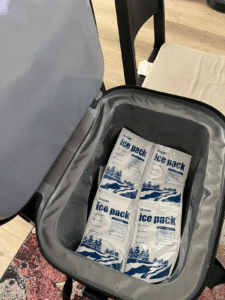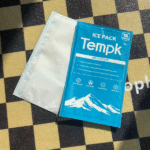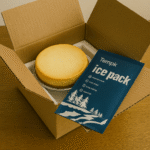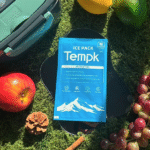Voyager avec de la glace sec dans les bagages à carreaux peut être essentiel pour maintenir le froid des articles sensibles à la température, Mais il y a des réglementations strictes à suivre. Comprendre comment emballer en toute sécurité la glace sèche, les restrictions sur le poids, Et l'emballage nécessaire est crucial pour assurer un voyage fluide. Cet article couvrira toutes les informations essentielles que vous devez savoir, des directives de la FAA à 2025 Tendances de la logistique de la chaîne du froid.
-
Combien de glace sèche pouvez-vous transporter dans les bagages à carreaux? Comprendre le 5.5 LB Limite et règles d'emballage.
-
Quelles sont les réglementations de la FAA et de la TSA? Aperçu de la façon dont la glace sèche est réglementée pour les voyages en avion.
-
Comment emballer en toute sécurité la glace sèche pour les voyages en avion? Conseils d'emballage pour se conformer aux normes de sécurité.
-
Quelles sont les alternatives à la glace sèche? Explorer d'autres options de refroidissement pour les bagages vérifiés.
-
Que sont les 2025 Tendances de la logistique de la chaîne du froid? Comment l'évolution de l'industrie pour une meilleure sécurité et durabilité.
Qu'est-ce que la glace carbaine et pourquoi est-elle réglementée?
Glace sèche est le dioxyde de carbone solide (Co₂) at a temperature of -78.5°C (-109.3°F), commonly used for shipping perishable goods and pharmaceuticals. The reason it’s regulated is due to its sublimation properties—it transitions directly from a solid to a gas, libérant du dioxyde de carbone (Co₂). Dans des espaces confinés, such as aircraft cargo holds, this gas can cause dangerous pressure buildup or displace oxygen, creating hazardous conditions.
Key Fact:
Dans des espaces confinés, Le CO₂ peut déplacer l'oxygène, posing suffocation or explosion risks, which is why strict regulations are in place for its transport
Can You Carry Dry Ice in Checked Luggage?
Oui, dry ice can go in checked luggage, but there are specific rules to follow to ensure safety. Selon le Administration fédérale de l'aviation (FAA) et Transportation Security Administration (TSA), you can carry up to 5.5 livres (2.5 kg) of dry ice in your checked luggage, provided the packaging is appropriate and the gas is able to escape.
Key Regulations for Carrying Dry Ice in Checked Luggage:
-
Quantité de glace sèche:
-
Limited to 5.5 livres (2.5 kg) par passager.
-
Exceeding this limit may require special arrangements or be subject to cargo restrictions
-
-
Conditionnement:
-
Must be packed in a récipient ventilé to allow CO₂ gas to escape as the dry ice sublimates.
-
Faire pas use airtight containers
-
-
Étiquetage:
-
Label the bag with «Glace sèche» ou « Dioxyde de carbone solide » along with the net weight or a statement indicating it doesn’t exceed the limit of 5.5 livres
-
-
Airline Policies:
-
Always check with your airline as they may have specific rules regarding dry ice transport .
-
Pour la pointe: Contact your airline ahead of time to avoid last-minute surprises regarding dry ice transport regulations
Comment emballer en toute sécurité la glace sèche pour les voyages en avion
Lors de l'emballage de la glace sèche, safety is key to avoiding accidents or mishaps. Here are essential tips to pack it properly for air travel:
-
Utilisez des conteneurs ventilés:
-
Opt for insulated coolers or specially designed dry ice containers with venting holes. These containers allow the CO₂ gas to escape safely.
-
-
Avoid Plastic Bags:
-
Never pack dry ice in plastic bags or airtight containers as they can cause dangerous pressure buildup
-
-
Utiliser l'isolation:
-
To ensure your items stay at the right temperature, wrap the dry ice in cloth or paper, and place items inside the cooler.
-
-
Assurer une ventilation adéquate:
-
Containers should have sufficient trous de ventilation, preferably near the top, to let CO₂ escape
-
-
Étiquetage approprié:
-
Ensure your bag is clearly labeled with “Dry Ice” or “Carbon Dioxide Solid,” along with the weight information.
-
Liste de contrôle d'emballage:
| Étape | Tâche | Votre avantage |
|---|---|---|
| Choose a vented container | Empêche l'accumulation de pression, ensures regulation compliance | Sûr, regulated transport |
| Utiliser des matériaux absorbants | Absorbs condensation, protects contents | Prevents frost damage to perishable goods |
| Label the bag | Meets FAA/TSA regulations | Easier airport inspection |
What Are the Alternatives to Dry Ice?
While dry ice is ideal for ultra-cold transport, it may not always be the best option for every situation. Here are some alternatives:
1. Packs de gel:
-
Packs de gel are a common alternative to dry ice for transporting items that need to stay cold but not frozen. These are safe for air travel, réutilisable, and don’t pose the risks associated with dry ice. Cependant, they only maintain moderate temperatures.
2. Bouteilles d'eau congelées:
-
A simple option for keeping items cool is to freeze water bottles before packing them. While this solution is less effective than dry ice, it can maintain the temperature for a short duration.
3. Matériaux à changement de phase (PCMS):
-
PCMS are substances that absorb or release heat at specific temperatures. They provide a stable temperature environment and are a sustainable alternative to dry ice. They are gaining popularity due to their environmental benefits.
2025 Trends in Cold Chain Shipping and Dry Ice Transport
The cold chain logistics industry is evolving with new technology and increasing demand for sustainability. Here are the top trends for 2025:
-
Technologies d'emballage intelligentes:
-
Real-time tracking of dry ice and temperature-sensitive goods is becoming more common with smart packaging, ensuring products remain at the correct temperature.
-
-
Alternatives durables:
-
There is an increasing demand for eco-friendly solutions, such as biodegradable gel packs and phase change materials (PCMS), reducing the reliance on traditional dry ice
-
-
Règlements plus stricts:
-
As safety concerns grow, stricter regulations are being introduced, especially for the transport of dry ice by air .
-
Questions fréquemment posées (FAQ)
Q1: How much dry ice can I carry in checked luggage?
You are allowed to carry up to 5.5 livres (2.5 kg) of dry ice in your checked luggage, as long as it’s packed in a vented container and labeled correctly.
Q2: Can I carry dry ice in my carry-on bag?
Oui, vous pouvez emporter de la neige carbonique dans votre bagage à main, but the same weight limit of 5.5 lbs s'applique. The container must also vent CO₂ and be clearly labeled.
Conclusion & Recommandations
En résumé, carrying dry ice in checked luggage is permissible under strict guidelines. Make sure to follow the weight limits, pack in a vented container, and label your bag correctly. En plus, consider alternative cooling methods like gel packs or PCMs for safer, more sustainable options.
Étapes suivantes:
-
Pack Correctly: Always pack dry ice in a vented container and ensure the weight does not exceed the limit.
-
Declare at Check-in: Notify the airline of your dry ice at check-in to avoid delays.
-
Restez à jour: Surveiller 2025 trends in cold chain logistics to explore sustainable alternatives for your travel.
À propos du tempk
Et tempk, we specialize in providing innovative cold chain solutions for transporting temperature-sensitive goods. We offer a range of options from dry ice to reusable gel packs and phase change materials, ensuring safe and reliable shipping.
Contactez-nous today for more information on cold chain shipping solutions!
























